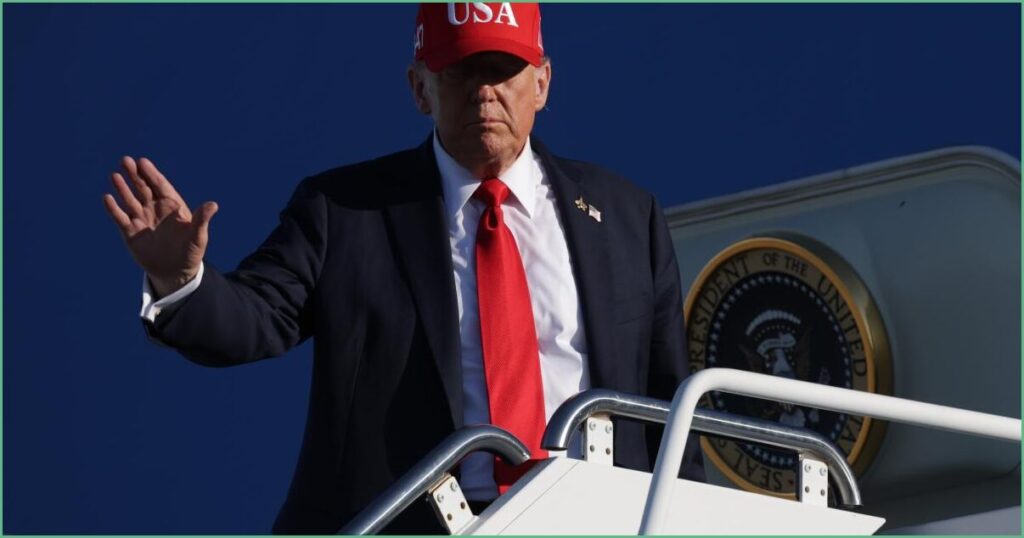Trump announces 100% China tariff over planned export controls
Donald Trump announced a sweeping trade response Friday: a 100% tariff on imports from China as a reaction to Beijing’s planned export controls. The president framed the move as a direct counter to what he called an aggressive and unacceptable change in the rules of global trade.
The move follows an earlier warning that the administration was preparing to impose export controls and that China was becoming “very hostile.” Republicans will read that line as confirmation the White House sees Beijing’s measures as a strategic challenge, not a routine policy shift.
“It has just been learned that China has taken an extraordinarily aggressive position on Trade in sending an extremely hostile letter to the World, stating that they were going to, effective November 1st, 2025, impose large scale Export Controls on virtually every product they make, and some not even made by them,” he posted on Truth Social. “This affects ALL Countries, without exception, and was obviously a plan devised by them years ago. It is absolutely unheard of in International Trade, and a moral disgrace in dealing with other Nations.”
“Based on the fact that China has taken this unprecedented position, and speaking only for the U.S.A., and not other Nations who were similarly threatened, starting November 1st, 2025 (or sooner, depending on any further actions or changes taken by China), the United States of America will impose a Tariff of 100% on China, over and above any Tariff that they are currently paying,” he went on. “Also on November 1st, we will impose Export Controls on any and all critical software.”
“It is impossible to believe that China would have taken such an action, but they have, and the rest is History. Thank you for your attention to this matter!” he concluded.
From a Republican viewpoint, the strategy is straightforward: show resolve and force China to reckon with consequences for sweeping economic coercion. The combination of tariffs and controls is meant to make any aggressive export policy prohibitively costly for Beijing.
Calling Beijing’s move ‘unprecedented’ and a ‘moral disgrace’ is part of the political case for swift retaliation, and the rhetoric will harden public support for tough measures. That framing matters because it converts a technical trade dispute into a question of national defense and economic sovereignty.
The inclusion of export controls on “any and all critical software” signals policymakers are thinking beyond widgets and hardware. That wording raises immediate questions about where commerce ends and security begins and how licensing regimes will be applied to cloud services, source code and embedded systems.
By setting November 1st, 2025 as the effective date, the administration created a rapid timeline that pressures both Beijing and U.S. industry to respond. Companies that rely on Chinese supply chains will have to evaluate contingency plans, and trading partners will watch for diplomatic coordination or divergence.
Enforcement will be complicated. Tariffs and export controls are handled by different agencies, and coordinating them while defending the measures in court and at trade bodies will be a complex, months-long effort.
Republicans who back this approach will emphasize reciprocity and national security, arguing that a firm, public response deters future coercion. Skeptics warn about market disruption, but supporters say the alternative is unchecked leverage by Beijing.
Corporate compliance teams will be scrambling to interpret sweeping language, since export controls can sweep up more than obvious hardware. That work will be messy and expensive, and firms that sell software, firmware and embedded services will be watching how exemptions and licenses are handled.
Manufacturers reliant on Chinese inputs could accelerate diversification or reshoring efforts, which supporters will argue strengthens long-term supply chain resilience. Short-term pain is likely, but the administration is betting that a credible threat will produce strategic shifts in sourcing and investment.
There is also the clear risk of escalation; Beijing can retaliate in kind or seek workarounds, and that dynamic risks an escalatory spiral that disrupts global trade patterns. Whether pressure forces concessions or deepens conflict will depend on the responses of other major economies and how quickly the costs ripple through markets.
The announcement shifts the debate from quiet diplomacy to a public economic showdown as the November 1 deadline nears.
